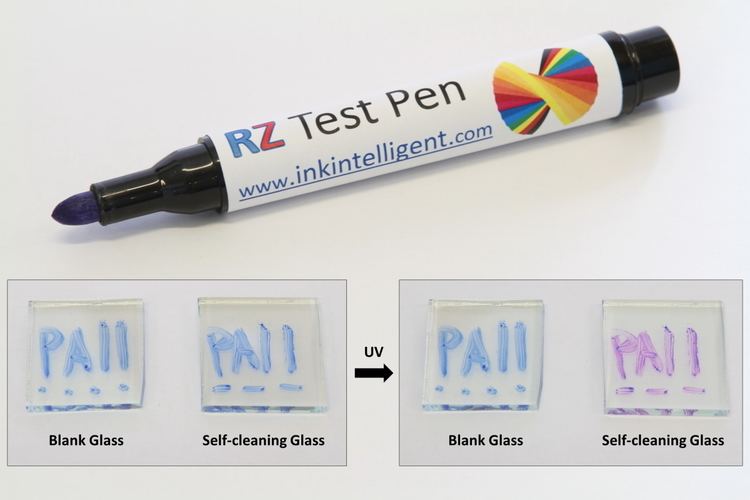 | ||
A photocatalyst activity indicator ink (Paii) is a substance used to identify the presence of an underlying heterogeneous photocatalyst and to measure its activity. Such inks render visible the activity of photocatalytic coatings applied to various "self-cleaning" products. The inks contain a dyestuff that reacts to ultraviolet radiation in the presence of the photocatalytic agent in the coating. They are applied to the coated product using a pen or brush, and show a color change or disappearance when exposed to ultraviolet.
Contents
Applications
A photocatalyst activity indicator ink quickly and easily identifies the presence of an underlying heterogeneous photocatalyst and provides a measure of its activity. A heterogeneous photocatalyst is a material that uses absorbed light energy (usually UV) to drive desired reactions that would not otherwise proceed under ambient conditions. Commercial photocatalytic products, which include: architectural glass, tiles, concrete, paint and fabrics. are marketed on their ability to clean their own surfaces (i.e. are self-cleaning) and the ambient air. Paiis address the industry need for a rapid, simple, inexpensive method to demonstrate and assess the activities of the usually thin, invisible to the eye, photocatalytic coatings present on self-cleaning products. A Paii, coated onto the surface of a photocatalyst material under test, works via a photoreductive mechanism, in which light absorbed by the photocatalyst drives the reduction of the dye in the paii, thereby producing a striking color change. Uses of paiis include: (i) laboratory, factory and on-site commercial photocatalyst product quality control (ii) marketing, for the rapid and striking demonstration of the efficacy of the usually invisible and otherwise slow-acting photocatalyst coating, (iii) counterfeit detection and (iv) evaluating new photocatalytic materials.
Background
Heterogeneous photocatalysis is the process that underpins the activity of most architectural materials, such as glass, tiles, concrete, paint and fabric, which are promoted as being 'self-cleaning'. These photocatalytic materials facilitate the oxidative mineralisation of organic and inorganic species by ambient oxygen on their surfaces, rendering the surfaces clean and, usually, hydrophilic. In most commercial photocatalytic products the active layer is a thin, clear, colourless coating of the semiconductor anatase titania, which requires UV light to photogenerate the necessary electrons (e−) and holes (h+), in its conductance and valence bands, respectively, to promote the photocatalytic process. A schematic of the key processes behind the photocatalytic mineralisation of an organic pollutant on the surface of a titania photocatalyst film is illustrated in figure 1 and the overall reaction is summarised by:
The marketing of photocatalytic products and prevention of counterfeiting is made difficult because the photocatalytic coatings are usually and necessarily invisible to the eye. One way to achieve a visual demonstration of photocatalysis is to use a dyestuff, like methylene blue, dissolved in water, as the organic species to be mineralised, since, as the photocatalytic process proceeds, the colour of the dye disappears as it is oxidised. This approach forms the basis of a well-established ISO test for photocatalytic activity of films ISO. However, most photocatalyst commercial products use only a thin layer of titania (e.g. ca. 15 nm thick in self-cleaning glass) and ambient UV levels are often low (e.g. for a sunny day in the UK the UVA irradiance is only ca. 4 mW/cm2). As a consequence, the photocatalytic oxidative bleaching of methylene blue is usually very slow, taking many hours, and so inappropriate for marketing at least.
Theory
Photocatalyst activity indicator inks (Paii's) are a recent advance in the visual demonstration of photocatalysis and the assessment of the activity of photocatalyst materials. They are an inexpensive, easy to use and provide a very quick route to demonstrating the presence of a photocatalytic film, even under low levels of UV light. Unlike the photo-oxidative bleaching of methylene blue, they use the underlying semiconductor photocatalyst film to photoreduce the dye (Dox in figure 2), in the ink coating, to another (usually colourless) form, (Dred in figure 2) whilst simultaneously oxidising an easily oxidised organic species, a sacrificial electron donor (SED), such as glycerol, which is also present in the ink. Figure 2 illustrates the basic principles of operation of a Paii when applied to a product that has a thin photocatalyst film coating.
Practise
The ink is applied to the photocatalyst coating, usually using either a felt-tipped pen, air-brush, rubber stamp or paint brush, and then exposed it to sunlight or an alternative, appropriate (invariably UVA) light source. The ink identifies the presence of the photocatalyst coating by changing colour upon irradiation of the latter at a rate (usually < 10 min) which provides a measure of the film's activity. For example, it has been established that the rate of change in colour of an Paii on commercial self-cleaning glass is directly related to the rate at which the glass is also able to photo-oxidatively mineralise, via reaction (1), the wax-like, natural fatty acid, stearic acid, found in finger prints. By making the dyes in the ink increasing difficult to reduce chemically, for example by using: basic blue 66, resazurin, and acid violet 7, respectively, it is possible to make Paii's which are effective on photocatalyst coatings which exhibit, respectively: low (most self-cleaning tiles), moderate (self-cleaning glass) or high (self-cleaning paints) activities. Currently Paii's are used as quality control and marketing tools in commerce and as a quick and easy way to assess and/or map the activities of new photocatalytic materials in research.
The rate of the rapid colour change associated with photocatalyst activity indicator inks has been directly correlated with the photocatalytic oxidation of stearic acid, methylene blue and NOx. In addition, it has also been demonstrated that such inks can be used on highly coloured and black surfaces, provided the oxidised and/or reduced form of the redox dye is luminescent.
Details and videos of a recent draft ISO proposal (ISO NP21066) based on the resazurin paii have been reported recently.
